Comparison of Polylactide-Based Active Films Containing Berberine and Quercetin as Systems for Maintaining the Quality and Safety of Blueberries
Abstract
1. Introduction
2. Materials and Methods
2.1. Material
2.2. Active Packaging Formation
2.3. Antioxidative Properties
2.4. Water Vapor Transmission Rate
2.5. Migration Tests
2.6. Fruit Storage and Firmness Method
2.7. Analysis of UV Protection
3. Results and Discussion
3.1. Comparison of Antioxidative Activity
3.2. Resistance to Water Vapor Permeation
3.3. Results for Specific Migration
3.4. Differences in Parameters of Stored Blueberries
3.5. UV Protection
4. Conclusions
Supplementary Materials
Author Contributions
Funding
Institutional Review Board Statement
Data Availability Statement
Conflicts of Interest
References
- Pérez-Gregorio, M.R.; García-Falcón, M.S.; Simal-Gándara, J. Flavonoids Changes in Fresh-Cut Onions during Storage in Different Packaging Systems. Food Chem. 2011, 124, 652–658. [Google Scholar] [CrossRef]
- Tavassoli, M.; Sani, M.A.; Khezerlou, A.; Ehsani, A.; McClements, D.J. Multifunctional Nanocomposite Active Packaging Materials: Immobilization of Quercetin, Lactoferrin, and Chitosan Nanofiber Particles in Gelatin Films. Food Hydrocoll. 2021, 118, 106747. [Google Scholar] [CrossRef]
- Bai, R.; Zhang, X.; Yong, H.; Wang, X.; Liu, Y.; Liu, J. Development and Characterization of Antioxidant Active Packaging and Intelligent Al3+-Sensing Films Based on Carboxymethyl Chitosan and Quercetin. Int. J. Biol. Macromol. 2019, 126, 1074–1084. [Google Scholar] [CrossRef] [PubMed]
- Jakubowska, E.; Gierszewska, M.; Szydłowska-Czerniak, A.; Nowaczyk, J.; Olewnik-Kruszkowska, E. Development and Characterization of Active Packaging Films Based on Chitosan, Plasticizer, and Quercetin for Repassed Oil Storage. Food Chem. 2023, 399, 133934. [Google Scholar] [CrossRef]
- Ma, K.; Zhe, T.; Li, F.; Zhang, Y.; Yu, M.; Li, R.; Wang, L. Sustainable Films Containing AIE-Active Berberine-Based Nanoparticles: A Promising Antibacterial Food Packaging. Food Hydrocoll. 2022, 123, 107147. [Google Scholar] [CrossRef]
- Kopka, B.; Kost, B.; Wrześniewska, J.; Rajkowska, K.; Kadłubowski, S.; Kunicka-Styczyńska, A.; Baryga, A.; Gonciarz, W.; Basko, M.; Brzeziński, M. Supramolecular Poly(Vinyl Alcohol)-Based Hydrogels Containing Quercetin for Bacterial and Fungal Elimination. Eur. Polym. J. 2023, 187, 111881. [Google Scholar] [CrossRef]
- Tongdeesoontorn, W.; Mauer, L.J.; Wongruong, S.; Sriburi, P.; Rachtanapun, P. Physical and Antioxidant Properties of Cassava Starch–Carboxymethyl Cellulose Incorporated with Quercetin and TBHQ as Active Food Packaging. Polymers 2020, 12, 366. [Google Scholar] [CrossRef] [PubMed]
- López-de-Dicastillo, C.; Alonso, J.M.; Catalá, R.; Gavara, R.; Hernández-Muñoz, P. Improving the Antioxidant Protection of Packaged Food by Incorporating Natural Flavonoids into Ethylene−Vinyl Alcohol Copolymer (EVOH) Films. J. Agric. Food Chem. 2010, 58, 10958–10964. [Google Scholar] [CrossRef]
- Masek, A.; Latos, M.; Piotrowska, M.; Zaborski, M. The Potential of Quercetin as an Effective Natural Antioxidant and Indicator for Packaging Materials. Food Packag. Shelf Life 2018, 16, 51–58. [Google Scholar] [CrossRef]
- Hu, X.; Yuan, L.; Han, L.; Li, S.; Zhou, W. The Preparation, Characterization, Anti-Ultraviolet and Antimicrobial Activity of Gelatin Film Incorporated with Berberine-HP-β-CD. Colloids Surfaces A Physicochem. Eng. Asp. 2020, 586, 124273. [Google Scholar] [CrossRef]
- Olewnik-Kruszkowska, E.; Gierszewska, M.; Richert, A.; Grabska-Zielińska, S.; Rudawska, A.; Bouaziz, M. Antibacterial Films Based on Polylactide with the Addition of Quercetin and Poly(Ethylene Glycol). Materials 2021, 14, 1643. [Google Scholar] [CrossRef]
- Olewnik-Kruszkowska, E.; Gierszewska, M.; Wrona, M.; Richert, A.; Rudawska, A. Polylactide-Based Films Incorporated with Berberine—Physicochemical and Antibacterial Properties. Foods 2023, 12, 91. [Google Scholar] [CrossRef]
- Brand-Williams, W.; Cuvelier, M.E.; Berset, C. Use of a Free Radical Method to Evaluate Antioxidant Activity. LWT-Food Sci. Technol. 1995, 28, 25–30. [Google Scholar] [CrossRef]
- Xiao, F.; Xu, T.; Lu, B.; Liu, R. Guidelines for Antioxidant Assays for Food Components. Food Front. 2020, 1, 60–69. [Google Scholar] [CrossRef]
- Olewnik-Kruszkowska, E.; Gierszewska, M.; Wrona, M.; Nerin, C.; Grabska-Zielińska, S. Polylactide-Based Films with the Addition of Poly(Ethylene Glycol) and Extract of Propolis—Physico-Chemical and Storage Properties. Foods 2022, 11, 1488. [Google Scholar] [CrossRef]
- Commission Regulation (EU) 2016/1416 of 24 August 2016 Amending and Correcting Regulation (EU) No 10/2011 on Plastic Materials and Articles Intended to Come into Contact with Food. Off. J. Eur. Union 2016, 22, 22–42.
- Alizadeh-Sani, M.; Mohammadian, E.; Rhim, J.W.; Jafari, S.M. PH-Sensitive (Halochromic) Smart Packaging Films Based on Natural Food Colorants for the Monitoring of Food Quality and Safety. Trends Food Sci. Technol. 2020, 105, 93–144. [Google Scholar] [CrossRef]
- Papadopoulou, E.L.; Paul, U.C.; Tran, T.N.; Suarato, G.; Ceseracciu, L.; Marras, S.; D’arcy, R.; Athanassiou, A. Sustainable Active Food Packaging from Poly(Lactic Acid) and Cocoa Bean Shells. ACS Appl. Mater. Interfaces 2019, 11, 31317–31327. [Google Scholar] [CrossRef] [PubMed]
- Tran, T.N.; Lim, K.T.; Fiorentini, F.; Athanassiou, A. Antioxidant and Biocompatible CO2-Based Biocomposites from Vegetable Wastes for Active Food Packaging. Adv. Sustain. Syst. 2022, 6, 2100470. [Google Scholar] [CrossRef]
- Cvek, M.; Paul, U.C.; Zia, J.; Mancini, G.; Sedlarik, V.; Athanassiou, A. Biodegradable Films of PLA/PPC and Curcumin as Packaging Materials and Smart Indicators of Food Spoilage. ACS Appl. Mater. Interfaces 2022, 14, 14654–14667. [Google Scholar] [CrossRef]
- Masuoka, N.; Matsuda, M.; Kubo, I. Characterisation of the Antioxidant Activity of Flavonoids. Food Chem. 2012, 131, 541–545. [Google Scholar] [CrossRef]
- Bors, W.; Michel, C. Chemistry of the Antioxidant Effect of Polyphenols. Ann. N. Y. Acad. Sci. 2002, 957, 57–69. [Google Scholar] [CrossRef] [PubMed]
- Zhou, J.Y.; Zhou, S.W. Protective Effect of Berberine on Antioxidant Enzymes and Positive Transcription Elongation Factor b Expression in Diabetic Rat Liver. Fitoterapia 2011, 82, 184–189. [Google Scholar] [CrossRef] [PubMed]
- Ma, X.; Chen, Z.; Wang, L.; Wang, G.; Wang, Z.; Dong, X.B.; Wen, B.; Zhang, Z. The Pathogenesis of Diabetes Mellitus by Oxidative Stress and Inflammation: Its Inhibition by Berberine. Front. Pharmacol. 2018, 9, 782. [Google Scholar] [CrossRef] [PubMed]
- Liu, Y.; Long, S.; Zhang, S.; Tan, Y.; Wang, T.; Wu, Y.; Jiang, T.; Liu, X.; Peng, D.; Liu, Z. Synthesis and Antioxidant Activities of Berberine 9-O-Benzoic Acid Derivatives. RSC Adv. 2021, 11, 17611–17621. [Google Scholar] [CrossRef] [PubMed]
- Razmara, R.S.; Daneshfar, A.; Sahraei, R. Solubility of Quercetin in Water + Methanol and Water + Ethanol from (292.8 to 333.8) K. J. Chem. Eng. Data 2010, 55, 3934–3936. [Google Scholar] [CrossRef]
- Lu, Y.-C.; Lin, Q.; Luo, G.-S.; Dai, Y.-Y. Solubility of Berberine Chloride in Various Solvents. J. Chem. Eng. Data 2006, 51, 642–644. [Google Scholar] [CrossRef]
- Li, L.; Cheng, J.; Lu, F.; Du, Y.; Xie, Y.; Zhou, C.; Zhang, J.; Feng, Y. Optimized HPLC Extraction Method of Quercetin and Berberine Based on Response Surface Analysis. RSC Adv. 2023, 13, 29427–29437. [Google Scholar] [CrossRef]
- Sangroniz, A.; Chaos, A.; Iriarte, M.; Del Río, J.; Sarasua, J.R.; Etxeberria, A. Influence of the Rigid Amorphous Fraction and Crystallinity on Polylactide Transport Properties. Macromolecules 2018, 51, 3923–3931. [Google Scholar] [CrossRef]
- Yadav, S.; Mehrotra, G.K.; Bhartiya, P.; Singh, A.; Dutta, P.K. Preparation, Physicochemical and Biological Evaluation of Quercetin Based Chitosan-Gelatin Film for Food Packaging. Carbohydr. Polym. 2020, 227, 115348. [Google Scholar] [CrossRef]
- Lu, L.J.; Lu, L.X. Preparation and Properties of Quercetin-Incorporated High Density Polyethylene/Low Density Polyethylene Antioxidant Multilayer Film. Packag. Technol. Sci. 2018, 31, 433–439. [Google Scholar] [CrossRef]
- Arvanitoyannis, I.S.; Bosnea, L. Migration of Substances from Food Packaging Materials to Foods. Crit. Rev. Food Sci. Nutr. 2004, 44, 63–76. [Google Scholar] [CrossRef] [PubMed]
- Luzi, F.; Pannucci, E.; Santi, L.; Kenny, J.M.; Torre, L.; Bernini, R.; Puglia, D. Gallic Acid and Quercetin as Intelligent and Active Ingredients in Poly(Vinyl Alcohol) Films for Food Packaging. Polymers 2019, 11, 1999. [Google Scholar] [CrossRef]
- He, T.; Wang, H.; Chen, Z.; Liu, S.; Li, J.; Li, S. Natural Quercetin AIEgen Composite Film with Antibacterial and Antioxidant Properties for in Situ Sensing of Al3+ Residues in Food, Detecting Food Spoilage, and Extending Food Storage Times. ACS Appl. Bio Mater. 2018, 1, 636–642. [Google Scholar] [CrossRef]
- Zhang, S.; Zhao, H. Study on Flavonoid Migration from Active Low-Density Polyethylene Film into Aqueous Food Simulants. Food Chem. 2014, 157, 45–50. [Google Scholar] [CrossRef] [PubMed]
- López-De-Dicastillo, C.; Gómez-Estaca, J.; Catalá, R.; Gavara, R.; Hernández-Muñoz, P. Active Antioxidant Packaging Films: Development and Effect on Lipid Stability of Brined Sardines. Food Chem. 2012, 131, 1376–1384. [Google Scholar] [CrossRef]
- Yin, X.; Tan, P.; Luo, H.; Lan, J.; Shi, Y.; Zhang, Y.; Fan, H.; Tan, L. Study on the Release Behaviors of Berberine Hydrochloride Based on Sandwich Nanostructure and Shape Memory Effect. Mater. Sci. Eng. C 2020, 109, 110541. [Google Scholar] [CrossRef] [PubMed]
- Zhang, X.; Miao, F.; Niu, L.; Wei, Y.; Hu, Y.; Lian, X.; Zhao, L.; Chen, W.; Huang, D. Berberine Carried Gelatin/Sodium Alginate Hydrogels with Antibacterial and EDTA-Induced Detachment Performances. Int. J. Biol. Macromol. 2021, 181, 1039–1046. [Google Scholar] [CrossRef] [PubMed]
- Mishra, P.; Brouwer, B.; Meesters, L. Improved Understanding and Prediction of Pear Fruit Firmness with Variation Partitioning and Sequential Multi-Block Modelling. Chemom. Intell. Lab. Syst. 2022, 222, 104517. [Google Scholar] [CrossRef]
- Ekrami-Rad, N.; Khazaei, J.; Khoshtaghaza, M.H. Selected Mechanical Properties of Pomegranate Peel and Fruit. Int. J. Food Prop. 2011, 14, 570–582. [Google Scholar] [CrossRef]
- Li, X.; Zhang, X.; Lv, J.; Zhang, X.; Li, Y.; Han, X.; Zhang, W. Development of Starch-Based Films Reinforced with Curcumin-Loaded Nanocomplexes: Characterization and Application in the Preservation of Blueberries. Int. J. Biol. Macromol. 2024, 264, 130464. [Google Scholar] [CrossRef] [PubMed]
- Zhao, X.; Han, Z.; Zhang, S.; Abuduaini, G.; Wen, X.; Liu, T.; Cheng, Z. Preparation of PVA/Tremella Polysaccharide and Soy Protein Isolate Complex/ε-Polylysine Active Membrane and Its Application in Blueberry Preservation. Food Packag. Shelf Life 2023, 40, 101163. [Google Scholar] [CrossRef]
- Tang, H.; Han, Z.; Zhao, C.; Jiang, Q.; Tang, Y.; Li, Y.; Cheng, Z. Preparation and Characterization of Aloe Vera Polysaccharide-Based Packaging Film and Its Application in Blueberry Preservation. Prog. Org. Coatings 2023, 177, 107445. [Google Scholar] [CrossRef]
- Mannozzi, C.; Tylewicz, U.; Chinnici, F.; Siroli, L.; Rocculi, P.; Dalla Rosa, M.; Romani, S. Effects of Chitosan Based Coatings Enriched with Procyanidin By-Product on Quality of Fresh Blueberries during Storage. Food Chem. 2018, 251, 18–24. [Google Scholar] [CrossRef] [PubMed]
- Ferri, M.; Papchenko, K.; Degli Esposti, M.; Tondi, G.; De Angelis, M.G.; Morselli, D.; Fabbri, P. Fully Biobased Polyhydroxyalkanoate/Tannin Films as Multifunctional Materials for Smart Food Packaging Applications. ACS Appl. Mater. Interfaces 2023, 15, 28594–28605. [Google Scholar] [CrossRef]
- Ezati, P.; Khan, A.; Priyadarshi, R.; Bhattacharya, T.; Tammina, S.K.; Rhim, J.W. Biopolymer-Based UV Protection Functional Films for Food Packaging. Food Hydrocoll. 2023, 142, 108771. [Google Scholar] [CrossRef]

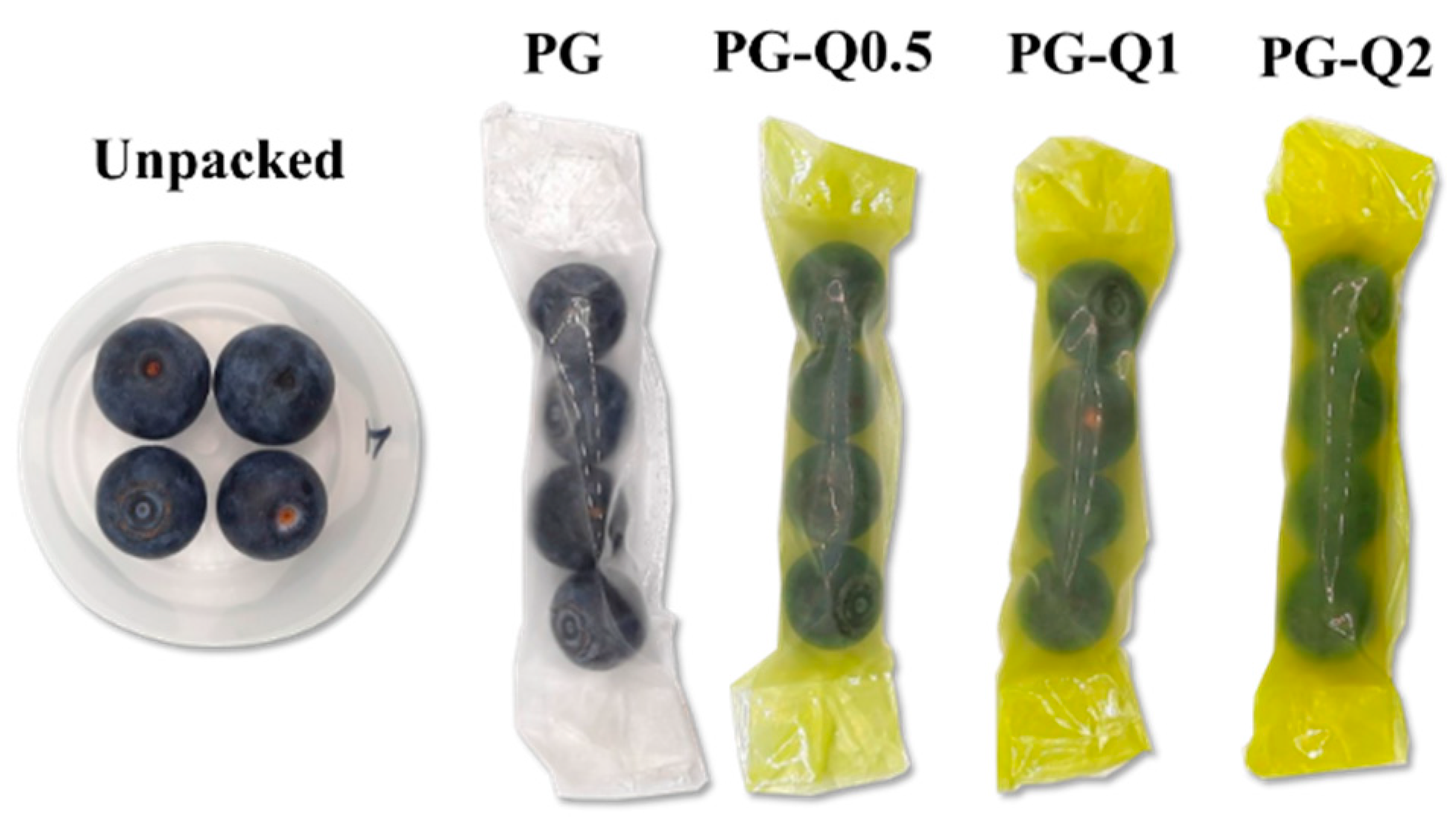
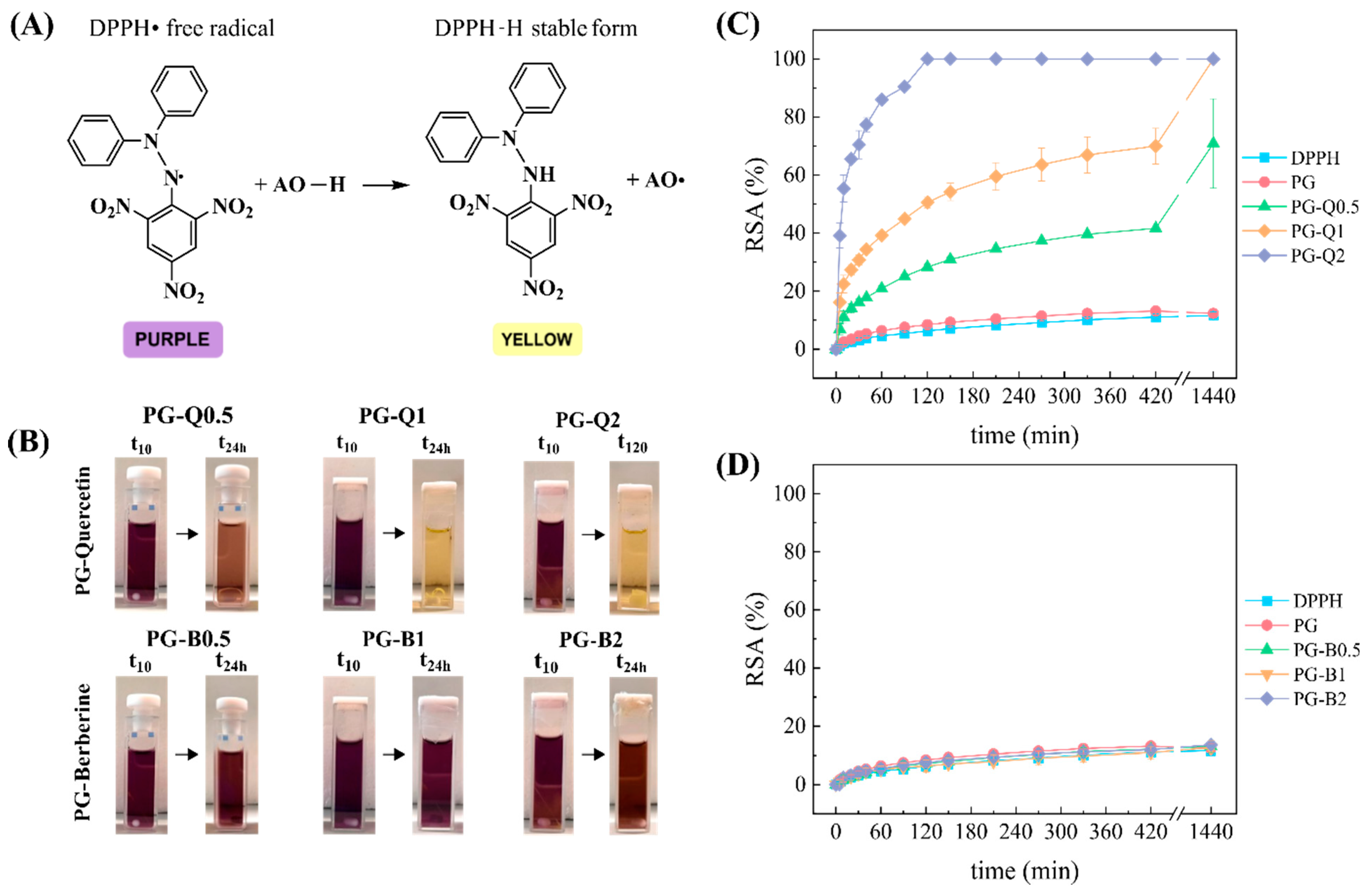
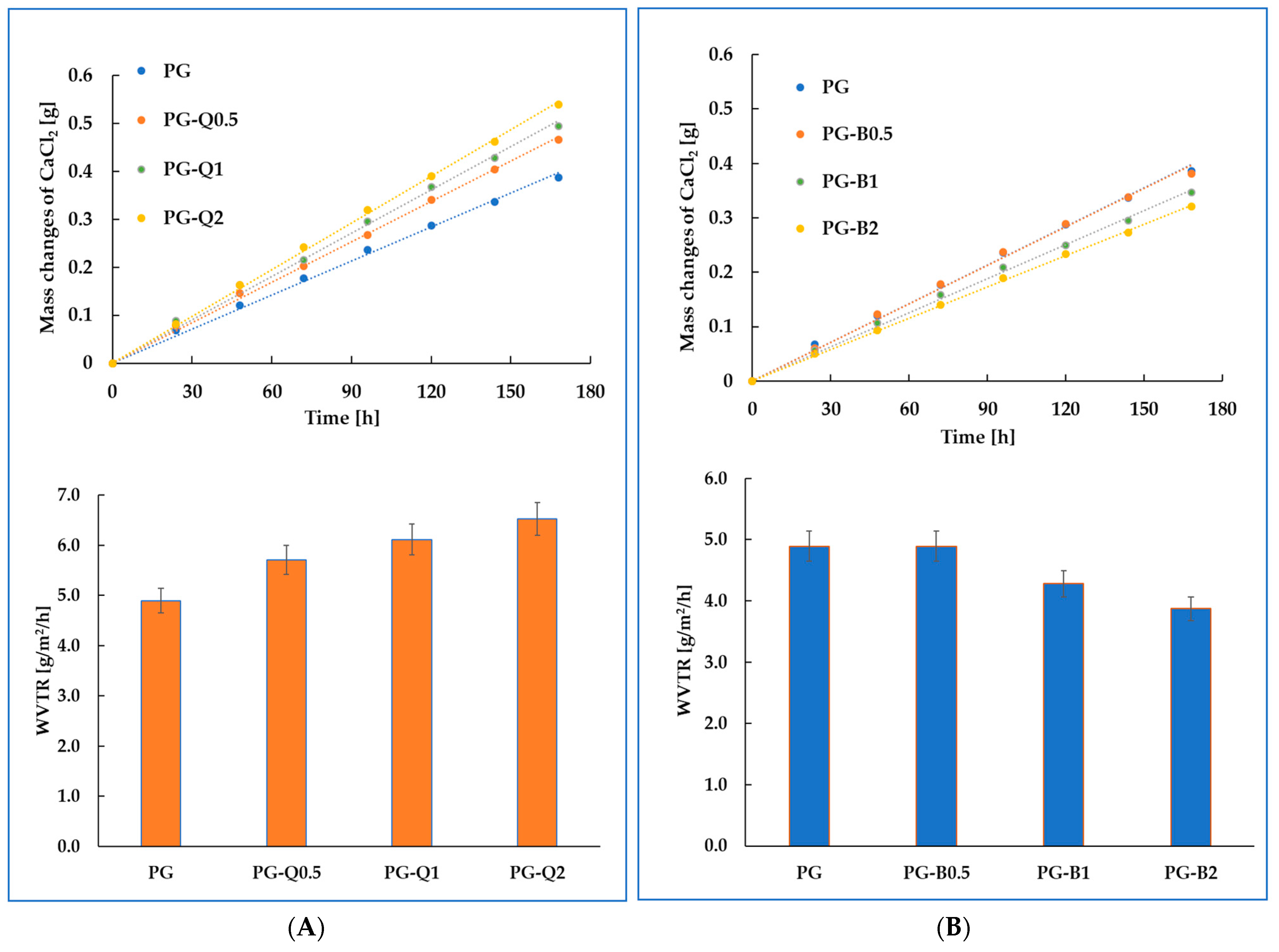
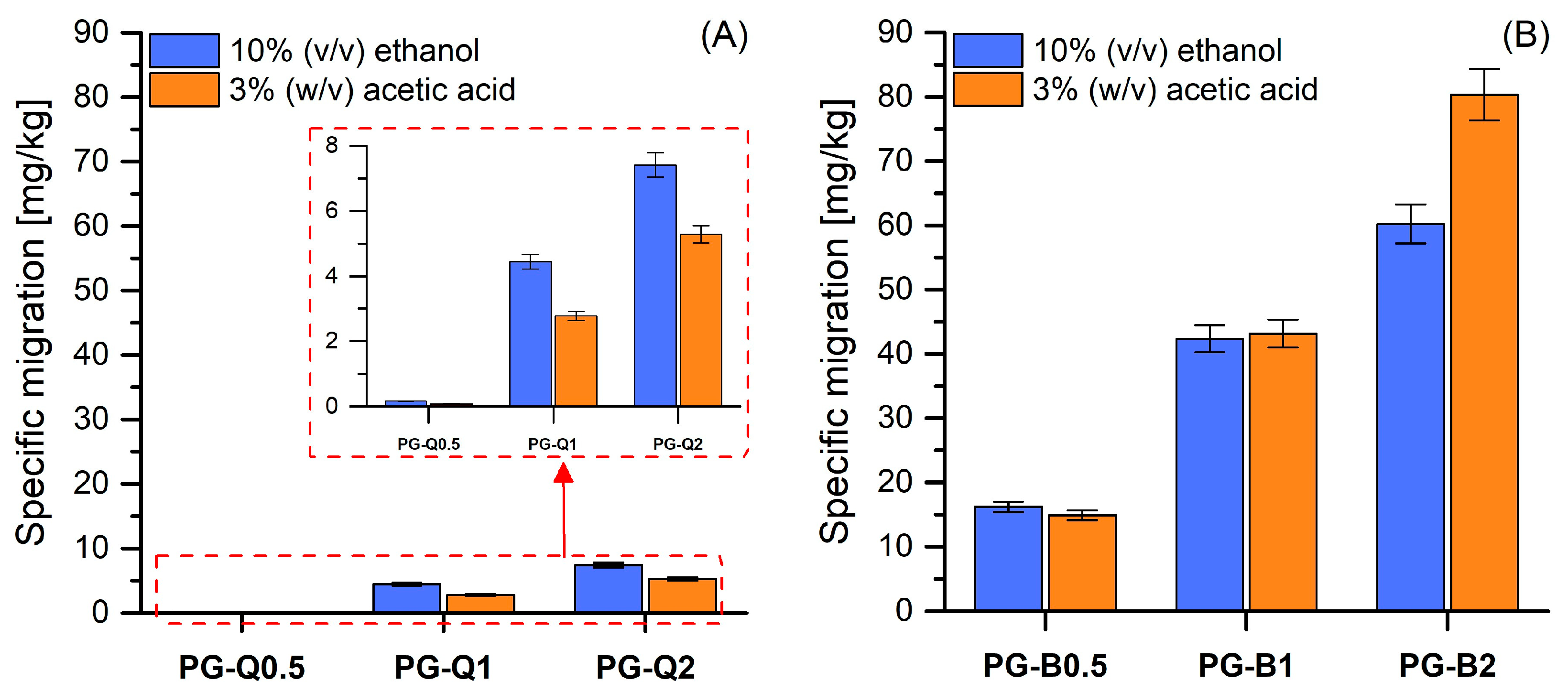
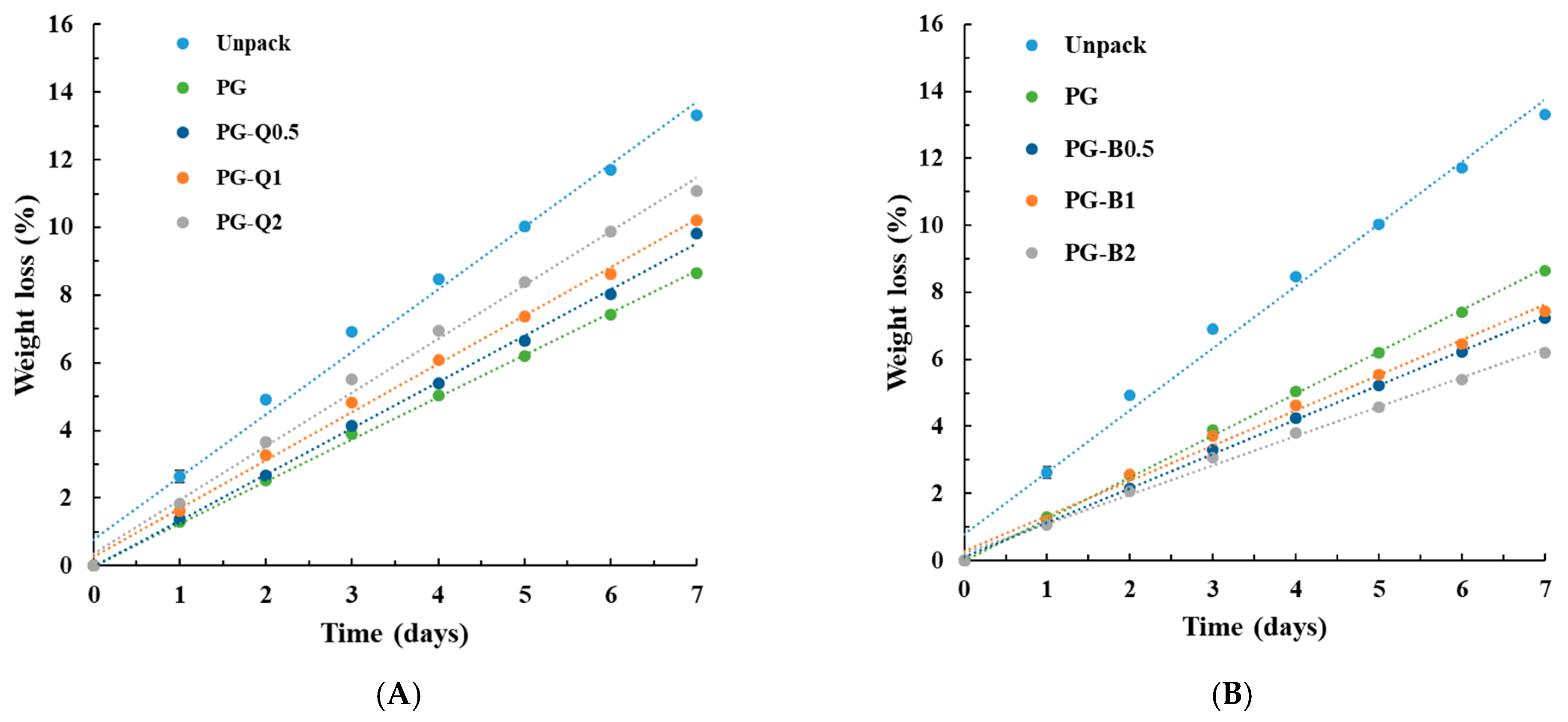
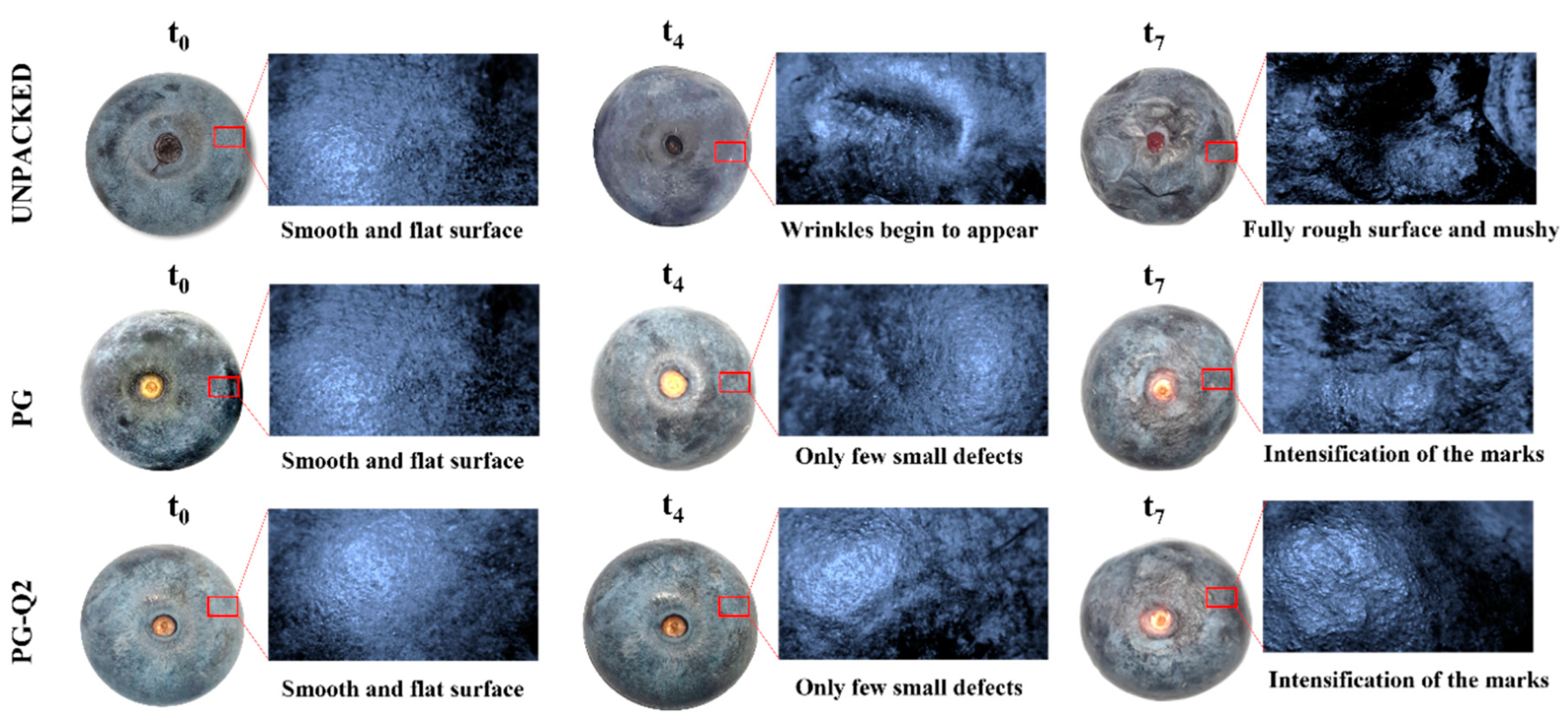
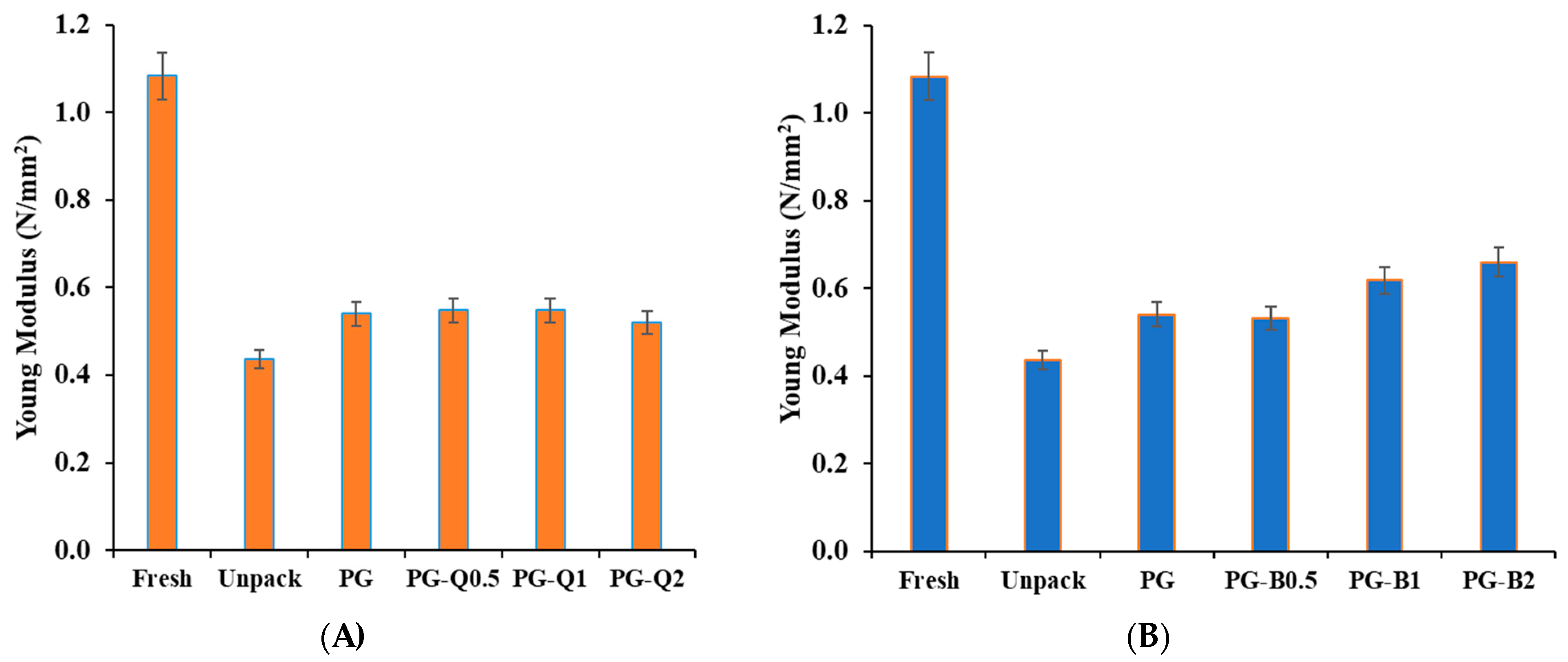

| Sample | Flavonoid Content % wt. * | PEG Content % wt. * |
|---|---|---|
| PG | - | 5 |
| PG-Q0.5 | 0.5 | 5 |
| PG-Q1 | 1 | 5 |
| PG-Q2 | 2 | 5 |
| PG-B0.5 | 0.5 | 5 |
| PG-B1 | 1 | 5 |
| PG-B2 | 2 | 5 |
Disclaimer/Publisher’s Note: The statements, opinions and data contained in all publications are solely those of the individual author(s) and contributor(s) and not of MDPI and/or the editor(s). MDPI and/or the editor(s) disclaim responsibility for any injury to people or property resulting from any ideas, methods, instructions or products referred to in the content. |
© 2024 by the authors. Licensee MDPI, Basel, Switzerland. This article is an open access article distributed under the terms and conditions of the Creative Commons Attribution (CC BY) license (https://creativecommons.org/licenses/by/4.0/).
Share and Cite
Olewnik-Kruszkowska, E.; Ferri, M.; Cardeira, M.C.; Gierszewska, M.; Rudawska, A. Comparison of Polylactide-Based Active Films Containing Berberine and Quercetin as Systems for Maintaining the Quality and Safety of Blueberries. Polymers 2024, 16, 1577. https://doi.org/10.3390/polym16111577
Olewnik-Kruszkowska E, Ferri M, Cardeira MC, Gierszewska M, Rudawska A. Comparison of Polylactide-Based Active Films Containing Berberine and Quercetin as Systems for Maintaining the Quality and Safety of Blueberries. Polymers. 2024; 16(11):1577. https://doi.org/10.3390/polym16111577
Chicago/Turabian StyleOlewnik-Kruszkowska, Ewa, Martina Ferri, Mariana C. Cardeira, Magdalena Gierszewska, and Anna Rudawska. 2024. "Comparison of Polylactide-Based Active Films Containing Berberine and Quercetin as Systems for Maintaining the Quality and Safety of Blueberries" Polymers 16, no. 11: 1577. https://doi.org/10.3390/polym16111577
APA StyleOlewnik-Kruszkowska, E., Ferri, M., Cardeira, M. C., Gierszewska, M., & Rudawska, A. (2024). Comparison of Polylactide-Based Active Films Containing Berberine and Quercetin as Systems for Maintaining the Quality and Safety of Blueberries. Polymers, 16(11), 1577. https://doi.org/10.3390/polym16111577








